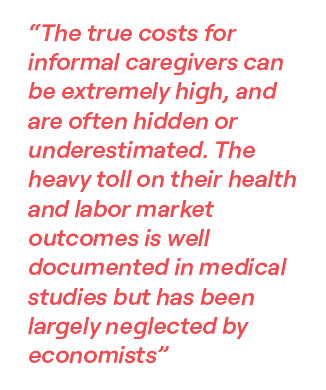As societies grapple with the huge challenges of aging populations, finding ways to finance and improve long-term care (LTC) services is a key objective for the TSE Health Center. To help inform public policies, Chiara Canta (TBS Business School) and Helmuth Cremer (TSE) examine how governments can best support families in a context in which elderly dependents often ‘pay’ for informal care by their children.
Many elderly people prefer to receive informal care from family members. So why is public intervention required?
Informal care by family members is a vital part of LTC services and has a number of attractive features. However, the true costs for informal caregivers can be extremely high, and are often hidden or underestimated. The heavy toll on their health and labor market outcomes is well documented in medical studies but has been largely neglected by economists.
 For parents, the major shortcoming of informal care is that it is subject to randomness and asymmetric information. Fertility cannot be fully controlled and the children’s cost of providing care or degree of altruism may not be known to parents when they make their LTC arrangements. Since private LTC insurance markets are very thin, the shortcomings of informal care create a potential role for well-designed public provision of care or insurance.
For parents, the major shortcoming of informal care is that it is subject to randomness and asymmetric information. Fertility cannot be fully controlled and the children’s cost of providing care or degree of altruism may not be known to parents when they make their LTC arrangements. Since private LTC insurance markets are very thin, the shortcomings of informal care create a potential role for well-designed public provision of care or insurance.
Why must policy design consider the motivations of informal caregivers?
LTC policies are likely to influence family transfers and informal care. In a fairy tale world, informal care would be motivated by altruism. In reality, care may be “bought” through implicit exchanges – including monetary transfers, gifts or bequests – or be “imposed” by social norms. Research suggests these three motives coexist and that their relative importance depends on the social and family context.
Our paper focuses on exchange-based transfers, the relevance of which has been widely documented. Children who provide informal care have been shown to receive larger inter vivos transfers. Bequests are less relevant empirically, as they are usually divided equally among children regardless of the amount of informal care provided.

Where does your paper break new ground?
Existing studies have mostly focused on parents’ welfare. By using a weighted sum of parents’ and children’s utilities, our approach explicitly takes into account caregivers’ wellbeing. In contrast to our previous research (Canta et al., 2020; Canta and Cremer, 2021) which assumed that informal care is only motivated by altruism, our current paper concentrates on families (or societies) where parents need to “buy” extra informal care through gifts or bequests to their children. We assume that children differ in their preferences, depending on their altruism, family bonds and many other factors, such as their working schedule, income and other commitments. These in turn affect their cost of providing care.
Inspired by Canta and Cremer (2019), we provide a much richer analysis of both the parents’ and the government’s optimal policy by considering a continuous distribution of children’s heterogeneity. Our model assumes that parents do not perfectly know their children’s preferences and their cost of providing informal care. Consequently, children may try to overemphasize their costs. In this case, parents cannot absorb the full surplus generated by the intrafamily exchange. They must leave a positive rent to all their children whose cost of providing care is lower than the highest level. The care provided by children with costs above the minimum level is therefore distorted downwards to mitigate the rent enjoyed by those with lower costs.
What are the policy implications?
The optimal uniform social LTC policy, providing a transfer to all dependent individuals financed by a uniform lump-sum tax on parents, affects levels of informal care as well as transfers to children. If the social planner only cares about parents, the risk of dependence is fully insured. As the importance of children’s wellbeing increases, the insurance coverage of parents is adjusted to enhance the rent enjoyed by the caregivers. However, the risk of having children with a high cost of providing care is never completely insured.
We also evaluate a nonlinear policy, assuming that LTC benefits can be conditioned on publicly observable intrafamily transfers. This policy can screen for the children’s cost of providing care, but only indirectly via the parents. Even if parents do not observe children’s costs, they have superior information since they observe informal care. This general policy can provide full insurance to parents, even against the risk of high-cost children.
Surprisingly, the optimal level of informal care increases as the importance of children’s wellbeing increases. This is because children receive compensation that increases with the level of informal care they provide. By improving children’s rents, the policy tends to mitigate the downward distortion introduced by parents.
Our calibrated numerical examples illustrate the empirical implications. In the uniform case, public care should represent about 40% of total care but it decreases to about 30% as the weight of children increases. In the nonlinear case, public care increases with children’s cost of providing care at a faster rate when children’s weight is higher. It represents 100% of total care for families with high-cost children.
These results are mirrored when the level of public care is related to the transfer that implements the optimal policy. This is a decreasing function, because parents with lower-cost children buy more informal care in exchange for larger transfers and thus “need” less social care. In our example, this function decreases at a lower rate as children’s weight increases. Intuitively, if the social planner cares a lot about children’s wellbeing, social care should not decrease too fast as intrafamily transfers increase, to ensure parents elicit (and pay for) a large amount of informal care.
FURTHER READING ‘Asymmetric information, strategic transfers, and the design of long-term care policies’ and other publications by Chiara and Helmuth are available to view on the TSE website.
Article published in TSE Reflect, April 2024




